Book of the Month
December 2008
The Bookman
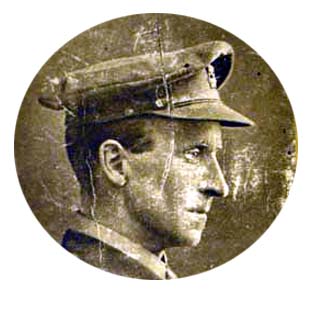
Special Christmas Number, 1918
London: 1918
MS Farmer 348/5
The 11th November 2008 marked the 90th anniversary
of the Armistice that brought the First World War to a close. Our
choice for December's Book of the Month returns to the first year of
that long-awaited peace with a feature on
The Bookman, Special Christmas Number, 1918. This issue
went to press in the month following the end of the
most destructive war in British history to date. In a feature-length
Christmas supplement, The Bookman periodical brings together a
variety of articles and reviews to pay tribute to the literary
heroes of the war.
|
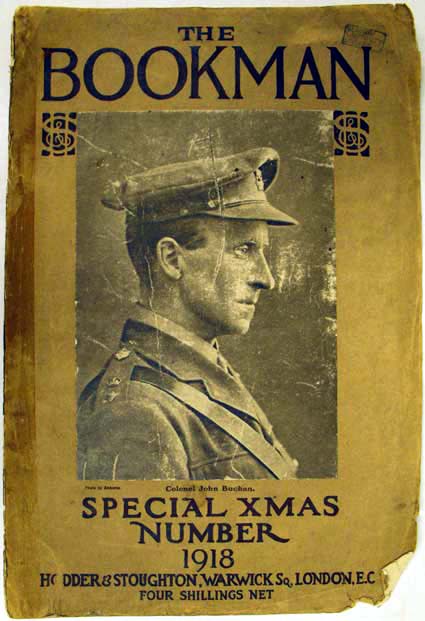
Front cover of The Christmas Edition, 1918 |
The Bookman
was a monthly literary periodical devoted to "Book buyers, Book
readers and Book sellers." It was established in 1891 by the
Aberdeen-born William Robert Nicoll, a liberal journalist working in
London, and ran until 1935 when it was absorbed by the London Mercury.
A middlebrow publication, priced at 6d, it was intended to appeal to
aspirational readers with limited disposable income. It offered book
reviews and colour illustrations as well as longer pieces of literary
criticism and special features on authors. The formula proved
commercially successful and became a platform for the publication of
early work by writers such as J. M. Barrie and W. B. Yeats.
The Bookman was, of
course, also an important advertising vehicle for its publishers Hodder & Stoughton, featuring many adverts and current publication
lists.
The annual Christmas Double Issue edition became a
popular institution, with its feature-length children's literature
supplement and colour illustration plates by notable artists.
Typically festive and colourful, it was the highlight of
The Bookman's publishing year. However,
after four years of war, the 1918 Christmas edition adopted a more
sombre tone, reflecting the solemnity of a bereaved nation. The
Christmas issue of 1918 focused instead on the significant literary
output of the war. The war touched every area of human consciousness
and literature proved no exception. In fact, in an age when poetry
formed an important part of the cultural diet of the population, the
First World War proved a great literary phenomenon. In the early
stages of the war, in August 1914, the Editor of
The Times was receiving 140 unsolicited poems a day for
publication. |
|
|
|
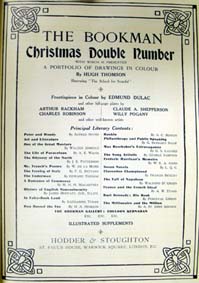 |
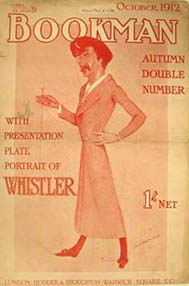 |
 |
|
Cover pages from other
issues of The Bookman
|
|
Christmas Double No,
December 1911
(Stack Gen Hum Pers Vol. 41) |
October 1912
(Sp Coll Whistler e1.20) |
October 1911
(Stack Gen Hum Pers Vol. 41)
|
|
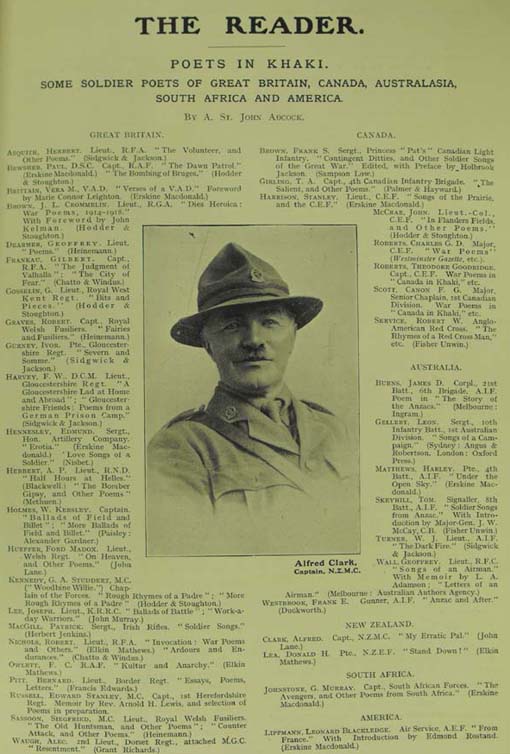
"Poets in Khaki," page 83 |
The first page of the supplement opens
with a printed memorial to the writers of the war. It reads as a Roll of
Honour, mimicking the form of stone memorials to fallen soldiers that
became so common during, and particularly after, the war. These
memorials became an iconic
aspect of the Great War legacy. The Imperial War Graves Commission
made the decision that bodies should remain where
they fell, and be interred in military cemeteries. Unable to access loved one's
graves, memorials provided an important substitute in the grieving
process. In
Britain, where one in six families suffered a bereavement, temporary
community memorials, roadside calvaries and monuments sprung up all
over the country. They expressed the desire for remembrance in the
aftermath of the war, with permanent memorials
forming the cornerstone of Remembrance Day and Memorial Ceremonies.
The use of names on memorials - a practice that had grown throughout
the 19th century - became almost universal in the Great War.
Prior to this, war memorials were intended to celebrate military
victories rather than mourn the dead, and rarely bore the names of the
fallen. In a century of devastating warfare, memorialisation
moved increasingly towards the commemoration of the dead and the recording of individual names
was adopted in an effort to find consolation and meaning. The largest
example of this was British architect Sir Edward Lutyen's Thiepval Memorial to the Missing of the
Somme bearing the names of 73, 367 missing, presumed dead, Allied
soldiers. Here, this practice is replicated in print form as the names
of war writers, both surviving and fallen, are presented alongside
the titles of their major works. |
As well as British writers, the supplement also
prints contributions from several different nations. Included are poets from America, Canada, South Africa,
Australia and New Zealand, acknowledging Britain's debt to her
Imperial and Commonwealth forces and the wider international community of
volunteers such as the French Foreign Legion and American recruits. This reflects the significance of the Great War as the
world's first truly
global conflict in which some 30 plus nations took part. |
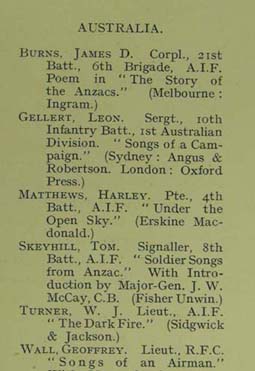
Detail from "Poets in Khaki"
memorial |
The writers honoured in this roll call are discussed
in further detail in the editorial piece "Poets in Khaki" by St. John Adcock. This
article of literary criticism offers a contemporary
perspective on the literature of the war and indicates that the war
generation were already aware of the lasting significance the
"enormous body of verse, touching on... infinitely varied aspects"
was to assume. It provides a detailed account of
the writing the author considers to be the most prominent, interspersed with portrait plates,
photographs and tributes to various writers who served in, and wrote
about, the war. In doing so, this article presents several writers of
the war who are now largely unread by modern
audiences. |
|
One such writer is the American Alan
Seeger. Now considered a relatively minor poet, his writing
captures that initial
spirit of idealism and enthusiasm so prevalent in the early war years. As a volunteer, it was the same sense of "triumphant
idealism" which St. John Adcock notes in Seeger's writing that
prompted him to sign up. With America officially neutral until 1917, Seeger joined the French Foreign Legion in a bid to reach the
Western Front. His poem, "Ode in Memory of the American Volunteers
Fallen for France," which is quoted at length in
The Bookman, perfectly sums up this sense of
romantic idealism. When "Europe's bright flag of freedom"
is threatened, he is eager to jump into the fray:
"Now heaven be thanked, we gave a few brave drops;
Now heaven be thanked, a few brave drops were ours."
The same longing for the perceived glamour and adventure
of war is also present in Seeger's most famous poem, "Rendezvous," in
which he eerily predicted his own death:
"I have a rendezvous with Death
On some scarred slope of battered hill,"
Seeger was to die, caught in machine gun fire, in July 1916. This welcoming of death displays a
touching naivety now ruefully associated with the Great War. These poems are similar in sentiment
to Rupert Brooke's sonnets, and perhaps suggest the
reason why Seeger's work is today not as popular as it was during the
war. It represents an earlier innocent
enthusiasm that seems so sadly ironic in
retrospect of the carnage that was to come. However, this mode of
writing was soon to give way to an unprecedented sense of realism
in war writing. As St. John Adcock goes on to show, the portrayal
of the "seamy" side of war continued to grow as idealism gave way
to disillusionment and a desire to "reveal the naked horror of the
realities" of battle. |
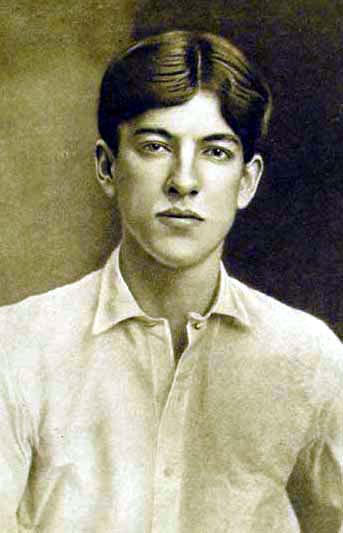
Alan Seeger, illustration plate, uncredited
|
|
|
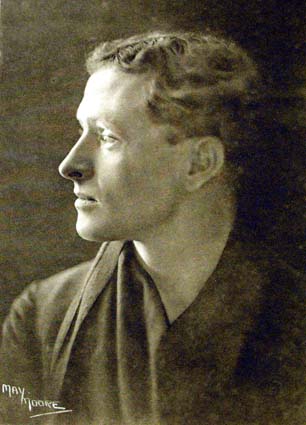
Leon Gellert, portrait plate,
photo by May Moore |
The epitome of what St. John Adcock describes as the "seamy"
representation of war can be found in the writing of Leon Gellert,
who was "terribly conscious of that revolting, inglorious underside
of war." Gellert, from Adelaide, was posted to Gallipoli after the
outbreak of war, but developed dysentery and septicaemia after three
days of solid fighting. He was discharged from army, but his
experience of the horrors of warfare found its way into his verse.
In "Songs of a Campaign" he chose to depict the effects of warfare
on the men who fought. His war poetry portrays grit, disillusionment
and "the piteous wreckage of humanity" in verses about the ordeal of
the soldier such as "The Attack at Dawn" and "Before Action," or the
after effects of war in "The Cripple," or "The Blind Man." In fact,
his writing is emblematic of the disillusionment that extended warfare brought,
and similar in tone (if less satiric) to that of the British poet
Siegfried Sassoon.
This type of anti-romantic war poetry was one of the great
revelations of the First World War. Where, in the past, an
idealistic language of noble and heroic battle had dominated war
writing, the First World War was said to have shattered notions of
heroism. St. John Adcock attributes this shift of perspective to the
mass conscription of the Great War, where armies consisted of
recruits rather than professional soldiers. |
|
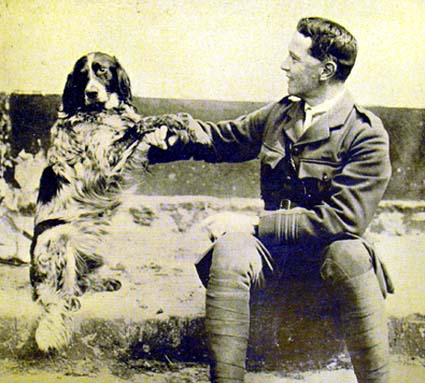
John McCrae in uniform, photo uncredited |
St. John Adcock touches on another Commonwealth
writer who responded to the tragic side of warfare. Canadian writer
John McCrae's "In Flander's Fields" is one of the more famous
poems of the war, still often used in Memorial Day Ceremonies, with
the opening lines:
"In Flander's fields the poppies blow,
Between the crosses, row on row".
It
employs typically elegiac conventions in offering pastoral consolation for the bereavement of
war. The poppies McCrae iconizes in his poem have become emblematic of the Great
War, and were chosen in 1921 as the most fitting symbol for the
British Legion's Poppy Appeal.
McCrae, a Canadian writer and doctor of Scottish Presbyterian
extraction, served as a medical officer in the war. He composed his famous poem during the Second Battle of Ypres
in 1915,
allegedly on a scrap of paper in the trenches in response to the death
of a comrade, Lieutenant Alexis Helmer. McCrae died of pneumonia on
the Western Front in the January of 1918, and is himself, now buried in one of the 2500 British military cemeteries in
Flanders. |
|
Another Commonwealth writer to whom Adcock turns is
Robert Service. Although labelled the
"Canadian Kipling," Service was born in Lancashire, and
raised in Hillhead in Glasgow.
He attended the newly-founded Hillhead Boys School, site
of the current Hillhead High - a fact commemorated today by a
plaque on site. He fostered dreams of becoming a cowboy in the days of Gold
Fever and emigrated to Canada aged 22 with just $5 in his
pocket. His appetite for travel and adventure was unquenched, however,
and his days were spent travelling the world. Living in Paris at the outbreak of the war, he joined a band of
volunteer American ambulance drivers. Despite his non-combatant role,
he experienced heavy shelling, and frequently came under fire. He recorded his
first-hand observations of war
in
Rhymes of a Red Cross Man. His
accessible style reached a mass audience in America and topped
bestsellers lists. In fact St. John Adcock claims in
The
Bookman "No Canadian poet has a wider popularity with
civilians and soldiers than Robert Service. I have heard ballads of
his recited in huts behind the lines in France." He quotes "Song of Winter
Weather" to demonstrate Service's popular touch
"No it isn't the guns,
And it isn't the Huns -
It's the MUD,
MUD,
MUD."Service's colloquial style emulated, and appealed to, the
common soldier. Yet it also conveyed the realism of day-today
conditions in the trenches rather than the excitement of battles
and charges.
Strangely, though originally immensely popular, Service's poetry and novels are now rarely read,
and his autobiographies are largely out of print. Perhaps one reason for this is that
his light-hearted humour and optimistic approach to the war appears,
in the eyes of modern-day readers, to trivialise the war. |

Robert Service, portrait plate,
photo by J. Kennedy |
|
Another writer popular at the time, and
especially with the troops, was Geoffrey Anketell Studdert Kennedy, more commonly known as Woodbine Willie.
A British parish priest, Reverend Studdert Kennedy served as a
chaplain in the British Army. He was extremely popular amongst
the troops for his compassion and courage in braving the front
line to help wounded and dying men. His nickname was bestowed
upon him for his habit of doling out the cheap and popular
Woodbine brand of cigarette that was favoured by the forces.
Woodbine Willie authored
Rough Rhymes of a Padre, a collection
of popular and humorous
rhymes as opposed to high literary output. Like Service,
his use of the vernacular
approximated the speech of the average grousing Tommy. |
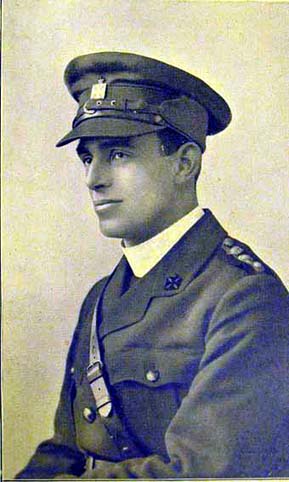
"Woodbine Willie" photo by W. W. & R. Dowly
|
|
|
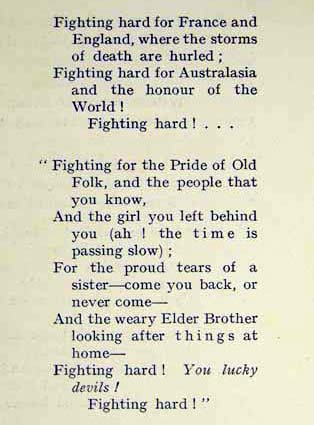
Detail from page 87, from "Fighting Hard" by C. J. Dennis |
The Australian equivalent of Woodbine Willie and
Robert Service was C. J. Dennis, "probably the most popular Australian
poet today," according to St. John Adcock. Although he didn't
serve in the army, his poetry dealt with the issue of the war. He
produced verse in a colloquial Aussie dialect through his characters,
such as Ginger
Mick and Doreen. "I suppose you fellers
dream, Mick, in between the scraps out there
Of the land yeh left be'ind yeh when yeh sailed to do yer share"
His writing was popular with the home audience for
some 50 years, and the initial print run for Songs of a Sentimental Bloke
of 40,000 - unheard of for poetry - sold out almost
immediately. It was lauded as the Australian troops' "trench bible" and
sold well in pocket editions small enough to carry to the trenches.
His writing is declared the "quaintest, liveliest, most picturesquely
colloquial of Australian war ballads" in
The Bookman, filled with "humour and
pathos." On Dennis' death, the Australian Prime Minister called
him the
"Robert Burns of Australia" for his canonisation of the Australian dialect
into literature. |
|
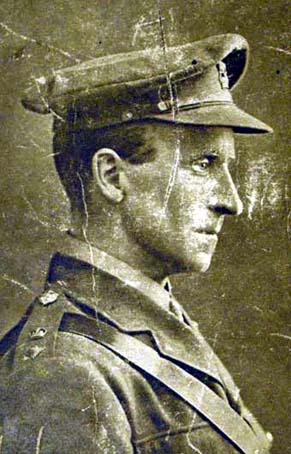
John Buchan, detail from title cover,
portrait
photo by Bassano |
The Bookman also pays tribute to the venerable
Scottish writer and Glasgow University graduate John Buchan in a
separate article by David Hodge, entitled "John Buchan as War Historian." Regrettably this section is missing from
Special Collection's copy of The Bookman,
and may have been torn out by the previous owner of
the periodical, Henry Farmer. Perhaps, as a fellow resident of
Glasgow, this article was of particular interest to Farmer or his
associates.
Buchan had several roles during the war. Unfit for service due to
a
lifelong health issue with stomach ulcers, he was instead given a notable role as Director of
Information at the War Office. He visited the Western Front twice, and was
involved in the authoring and dissemination of propaganda. He was also
a celebrated fiction writer whose spy-catcher series - including titles
such as The Thirty-Nine Steps and
Greenmantle - spanned
the war years. The focus
of the article, however, is Buchan's work as the principle writer on
the contemporary serial,
Nelson's History of the War, which recorded the history of the war
as it was happening. Hodge praises the "lucidity" of the history
serial, which explains complex military operations simply and adopts a
cool perceptive tone. He declares it to be as readable as Buchan's
fiction. |
| The Bookman's
supplement on the literature of the war is an original document
from a period that still fascinates current generations. It offers
a contemporary perspective on writers who were read by those who
lived through the war, offering us poets that have long-since
fallen into obscurity. The Big Name poets of Wilfred Owen,
Isaac Rosenberg and Rupert Brooke who today dominate the landscape
of First World War poetry, are notable in their absence. The Great
War will soon pass out of living memory and valuable sources such
as this will soon prove to be our only link to the past and the
attitudes of those who lived through such an epoch-making period. |
|

Detail from the front cover |
|
|
Other items of interest
John Buchan A History of the Great War
London: Nelson 1921, 1922
Level
8 Main Library History BM 170BUC vol. 1-4
Robert Service
Collected Poems New York: Dodd, Mead, 1961
Level 9 Main Lib English NS210 1961
The Bookman, October 1912, Portrait of
Whistler Level 12 Main Lib Sp Coll
Whistler e1.20
The Bookman,
volumes 7, 9, 10, 15-18, 36, 38, 39, 41, 63, 68
Library
Stack Main Lib
Gen Hum Pers
The following have been useful in compiling
this article:
Philip Butterss, "C. J. Dennis"
Dictionary of Literary Biography Volume 260 Australian Writers
1915-1950, edited by Selina Samuels. Detroit, London:
Gale Research Group, 2002
Level 9 Main
Lib Gen Literature
qE10 DIC Vol 260
Niall Fergusson
The Pity of War London: Allen Lane 1998
Level 8 Main Lib History BM100 FER
Paul Fussell The
Great War and Modern Memory Oxford: Oxford University Press 2000
Level 9 Main
Library English E478.W2 FUS
Carole Gerson, "John McCrae" Dictionary
of Literary Biography Volume 92 Canadian Writers, 1890 - 1920 Edited
by W. H. New Detroit Michigan London?: Gale Research Group, 1990
Level 9 Main
Lib Gen Literature
qE10 DIC Vol 92
James A. Hart, "Alan Seeger" Dictionary
of Literary Biography Volume 45 American Poets, 1880 - 1945 Edited
by Peter Quartermain Detroit, London:
Gale Research Group/Bruccoli, 1986
Level 9 Main Lib
Gen Literature
qE10 DIC
Vol 45
Samuel Hynes A War
Imagined; A War Imagined: The First World War and English Culture
London: The Bodley Head, 1990. [Not in Glasgow University Library but
available in
the Mitchell Library,
942.08370 HYN]
Alex King
Memorials of the Great War in Britain Oxford, New York:
Berg 1998
Level 8 Main
Library History BM 1770 KIN
Carl F. Klinck & W. H. New, "Robert
Service" Dictionary of Literary Biography Volume 92 Canadian
Writers, 1890 - 1920 Edited by W. H. New Detroit Michigan London?:
Gale Research Group/Bruccoli, 1990
Level 9 Main Library
Gen Literature
qE10 DIC Vol 92
James MacKay Robert Service, Vagabond
of Verse Edinburgh: Mainstream Publishing, 1995
Level 9 Main Library
English NS211 MACKA
Janet Adam Smith
John Buchan: A Biography London: Hart-Davis, 1965
Level 9 Main Library
English NB751 SMI
Jay Winter Sites of Memory, Sites of
Mourning Cambridge: Cambridge University Press, 1995
Level 8 Main Library
History BM1770 WIN
"Introducing: William Robertson Nicoll" by Jason Goroncy
at Wordpress,
http://cruciality.wordpress.com/2008/07/15/introducing-william-robertson-nicoll (page accessed 19/6/08)
Return to main Special Collections
Exhibition Page
Go to previous
Books of the Month
Aimee Cook (Graduate Trainee
on placement in Special Collections), December 2008
|